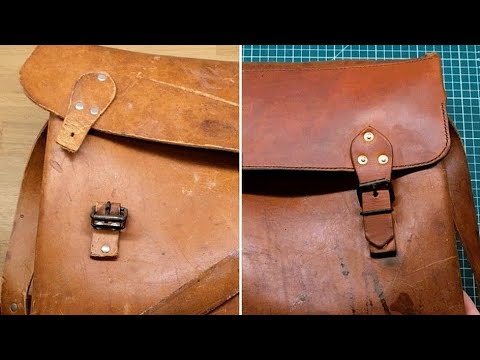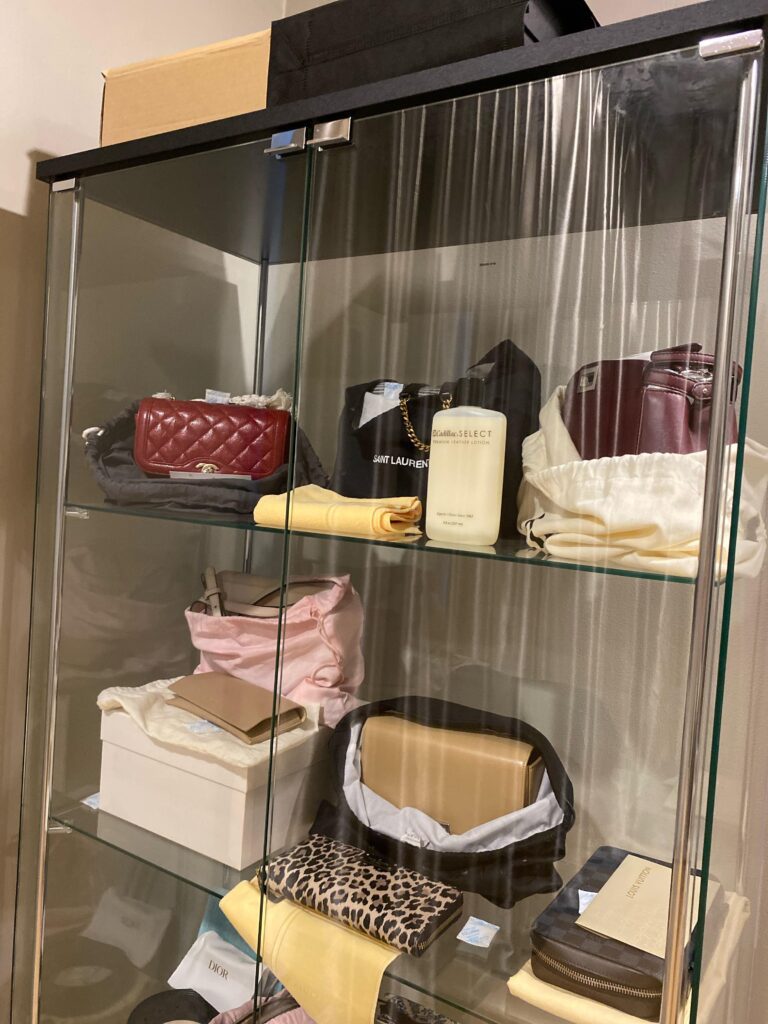How to Restore Leather Bag for a Fresh Look
Restoring Leather Bags
Revitalizing your leather bag can enhance its longevity and maintain its appeal. Let’s explore methods for addressing common imperfections like scratches.
Repairing Light Scratches
For light scratches, you can use a few household items to minimize their appearance:
-
Leather Oil or Conditioner:
- Apply a small amount of leather oil or conditioner directly onto the scratch.
- Gently rub it in a circular motion using a soft cloth.
- Remove any excess product with a dry cloth to ensure the leather doesn’t remain oily.
- This method helps nourish the leather and can make scratches less noticeable.
-
Vaseline:
- Dab Vaseline onto the scratch.
- Use your finger or a soft cloth to gently rub it in.
- Wipe away any extra Vaseline with a clean cloth.
- Vaseline helps to moisturize and smooth out the leather.
For further details on cleaning procedures, check how do you clean a leather bag.
Treating Deeper Scratches
Deeper scratches require more intensive treatment but can still be addressed effectively:
-
Clean the Leather:
- Use a leather cleaner to cleanse the affected area. Ensure the leather is dry before proceeding.
-
Distilled White Vinegar:
- Dab a small amount of distilled white vinegar onto a soft cloth.
- Apply it to the scratch in circular motions.
- Allow the leather to dry naturally – the vinegar’s acidity helps the leather fibers swell and conceal the scratch.
-
Colorless Shoe Polish:
- After the vinegar treatment, apply colorless shoe polish over the scratch.
- Buff the area with a soft cloth to blend the polish into the leather’s surface.
-
Olive Oil:
- As an alternative, gently rub olive oil into the scratched area.
- Wipe off any remaining oil with a dry cloth.
- This method adds moisture and can blend the scratch into the leather.
For step-by-step techniques, visit how to remove scratches from leather bag.
| Treatment Method | Tools/Products Needed | Primary Benefit |
|---|---|---|
| Leather Oil/Conditioner | Leather oil, soft cloth | Nourishes leather, minimizes scratch visibility |
| Vaseline | Vaseline, soft cloth | Moisturizes and smoothens leather |
| Distilled White Vinegar | Vinegar, soft cloth | Swells leather fibers, making scratches less visible |
| Colorless Shoe Polish | Shoe polish, soft cloth | Blends scratches into the leather |
| Olive Oil | Olive oil, soft cloth | Moisturizes leather, blends scratches |
By using these methods, you can effectively restore the appearance of your leather bag, ensuring it retains its stylish look. For more advanced care techniques, explore our guides on restoring color and finish and addressing wear and tear.
Maintenance Tips for Leather Bags
Learning proper maintenance tips is essential in ensuring your leather bags remain in top condition. Here, we’ll cover the basics of cleaning and conditioning, as well as identifying different types of leather.
Cleaning and Conditioning
Routine cleaning and conditioning are imperative for maintaining leather bags. Regular upkeep not only extends the life of the bag but also keeps it looking fresh and new.
Basic Cleaning
- Use a soft, damp cloth to wipe down the surface of the leather bag regularly to remove dust and grime.
- For deeper cleaning, choose a specific leather cleaner appropriate for the type of leather your bag is made of (Leather N Luxury).
Deep Cleaning
- Perform a thorough cleaning every 6 to 12 months. This involves removing dirt accumulation and tougher spots with a proper leather cleaning solution (LeatherNeo).
- Clean both the interior and exterior. Rinse out the interior with a mild soap solution if needed.
| Cleaning Essentials | Usage |
|---|---|
| Soft cleaning cloth | Wiping down |
| Gentle brush | Tackling tough spots |
| Leather cleaner | Deep cleaning |
Conditioning
- Apply a high-quality leather conditioner after cleaning to keep the leather smooth and moisturized (LeatherNeo).
- Conditioners help in replenishing the natural oils in leather, preventing cracks and dryness.
If you prefer DIY solutions, mild soap solutions or mixtures of white vinegar and water can be effective. However, it’s important to test DIY solutions on a small, less visible area to avoid any potential damage (Leather N Luxury).
For specific advice on maintaining certain types of bags, such as how to clean a Michael Kors leather bag, see our guide here.
Identifying Leather Types
Not all leather is created equal, and knowing the specific type of leather your bag is made from helps tailor your maintenance approach.
| Leather Type | Characteristics | Maintenance Tips |
|---|---|---|
| Full-grain leather | Durable, natural look | Regular conditioning |
| Top-grain leather | Smooth, processed surface | Avoid excessive moisture |
| Genuine leather | Lower quality, processed | Frequent cleaning required |
| Patent leather | Shiny, sleek finish | Use gentle, non-abrasive cleaners |
Identify the leather type to determine the appropriate care regimen. Luxurious bags, particularly those made from high-quality leather, demand special attention and proper maintenance (LeatherNeo).
Understanding leather types ensures that your efforts in cleaning and conditioning are effective and prevents potential damage. For more information, visit our article on how to clean shiny leather bag.
To maximize the longevity of your leather bag and retain its aesthetics, familiarize yourself with these essential tips and internalize care routines.
Specific Care Techniques
Maintaining your leather bag in pristine condition requires specific care techniques to address common issues such as fading color and wear and tear. Here are some effective methods to restore and rejuvenate your beloved accessory.
Restoring Color and Finish
Restoring the color and finish of your leather bag involves careful application of colorants and protective treatments. Here’s how you can do it:
- Leather Colorants: Choose a leather colorant that matches your bag’s original color closely. Leather colorants come in various shades and can restore vibrancy to faded leather. Steel Horse Leather
- Application Process: Apply the colorant evenly using a sponge or soft cloth. Multiple layers may be needed for an even finish. Allow each layer to dry before applying the next.
- Topcoat Protection: After achieving the desired color, apply a topcoat to protect the newly colored leather and enhance its durability. This topcoat seals the color and provides a glossy finish.
For more detailed steps on coloring leather, check our guide on how to color leather bag.
Addressing Wear and Tear
Dealing with wear and tear on leather bags involves several steps to repair and rejuvenate the material.
Light Scratches
- Cleaning: Clean the leather with a leather cleaner to remove any dirt and oils.
- Vinegar Treatment: Dab the scratched area with distilled white vinegar to help the leather swell and fill in the scratch. MAHI Leather
- Polishing: Use colorless shoe polish to buff the scratch, making it less visible.
- Oil Treatment: Try applying a small amount of olive oil to blend in the scratch and restore the leather’s natural sheen.
| Step | Description |
|---|---|
| Cleaning | Use a leather cleaner to remove any dirt and oils. |
| Vinegar Treatment | Dab distilled white vinegar on the scratch to help it swell and fill in. |
| Polishing | Buff the scratch with colorless shoe polish. |
| Oil Treatment | Apply a small amount of olive oil to blend in the scratch and restore shine. |
Deeper Scratches and Wear
- Filler Application: Apply a leather filler to the scratched area. The filler creates a smooth surface.
- Sanding: Once the filler is dry, gently sand the area to ensure it is level with the rest of the leather.
- Dye Application: Use a leather dye that matches the color of your bag to cover the repaired area. Apply multiple thin layers for an even finish.
- Topcoat: Apply a protective topcoat to seal the repair and prevent future damage.
For extensive repair techniques, refer to how to remove scratches from leather bag.
These techniques will help you maintain the aesthetic appeal of your leather bag, ensuring it lasts for years to come. For additional care tips and tricks, explore our articles on how to clean coach leather bag and how to store leather bags.
Preventing Damage to Leather Bags
Preventing damage to your leather bags involves proper storage and avoiding common mishandling mistakes. Follow these guidelines to keep your leather bag looking fresh and well-maintained.
Storage and Handling
Correct storage and handling practices are essential to maintaining the quality of your leather bags. Below are key tips:
-
Avoid Direct Sunlight and Artificial Heat: Store your leather bag away from direct sunlight and artificial heat sources, such as radiators and heaters. Heat can cause the leather to dry out and crack. (Aspinal of London)
-
Use Proper Storage Containers: Avoid using plastic bags for storage. Instead, use a dust bag or a white cotton pillowcase to cover your bag, which allows the leather to breathe.
-
Protect Hardware: Wrap hardware such as zips and clasps in tissue paper to prevent imprints on the leather. This will help you avoid indentations and preserve the shape of your bag.
-
Standing vs. Hanging: Keep your bag standing upright on its base rather than hanging by the handles to prevent stretching and warping (Aspinal of London).
-
Stuff the Bag: Use tissue paper or bubble wrap to stuff your leather bag. This helps in maintaining its shape during storage.
-
Avoid Overloading: Do not overstuff your leather bag as this can cause it to lose its shape over time.
| Storage Tip | Description |
|---|---|
| Avoid Sunlight | Keeps leather from drying and cracking |
| Proper Storage Bag | Use dust bags or cotton pillowcases |
| Protect Hardware | Wrap zips and clasps in tissue paper |
| Stand on Base | Prevents stretching and warping |
| Stuff the Bag | Maintains bag shape |
Avoiding Common Mistakes
It’s crucial to be aware of common mistakes that can inadvertently damage your leather bag. Here are some pitfalls to avoid:
-
Improper Cleaning Products: Always use a high-quality leather cleaner and conditioner. Inappropriate products can cause irreversible damage (Leather N Luxury). For more tips on cleaning, see our guide on how to clean coach leather bag.
-
Skipping Regular Cleaning and Conditioning: Leather needs to be cleaned and conditioned regularly to maintain its suppleness. Learn more about cleaning leather bags in our article how do you clean a leather bag.
-
Ignoring Spills and Stains: Address spills and stains immediately to prevent long-lasting damage. For specific types of stains, read our articles on how to remove ink from leather bag and how to remove old oil stain from leather bag.
-
Not Protecting During Travel: Use a protective luggage cover for leather travel bags to prevent scratches during transit. Always store them standing, rather than folding handles or laying them flat (Aspinal of London).
-
Incorrect Storage Conditions: Never store your leather bag in a damp or humid environment as this can encourage mold and mildew growth.
By following these preventive measures, you can significantly extend the life of your leather bag and maintain its pristine appearance. For more detailed techniques and tips, check out our related articles on how to store leather bags and how to remove scratches from leather bag.







